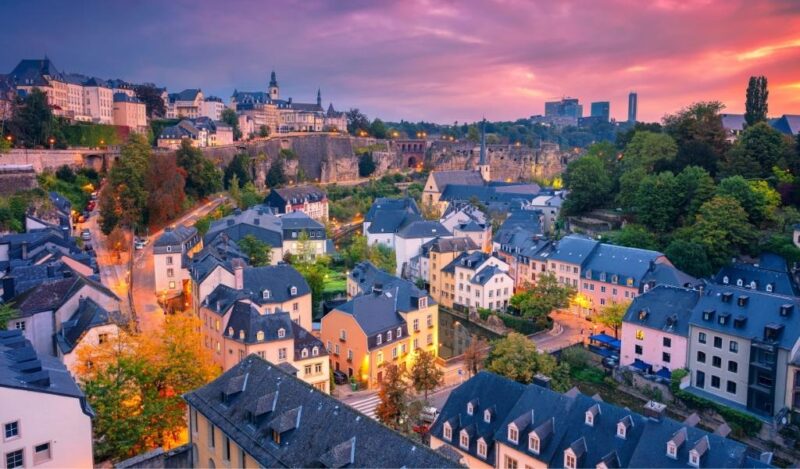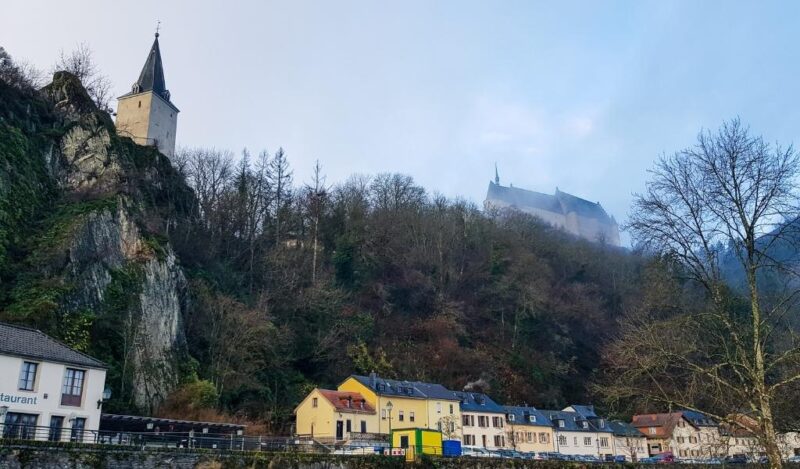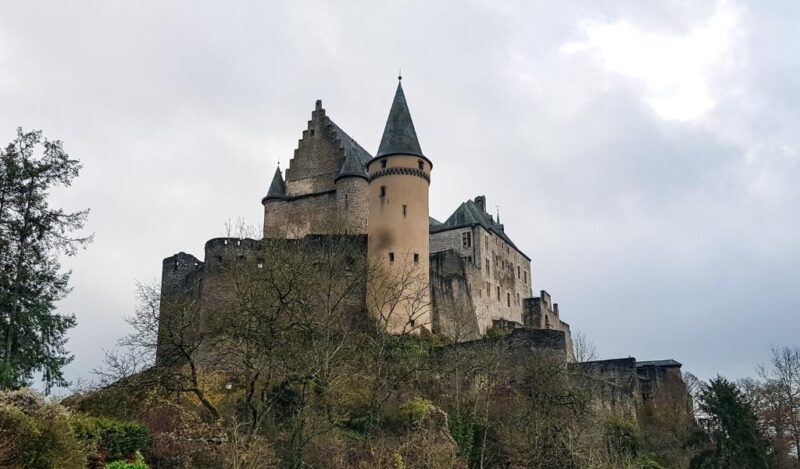The Victor Hugo House – Literary Museum (in Luxembourgish, Victor Hugo Haus – Literaturmusée; in French, Maison Victor Hugo – Musée littéraire; and in German, Victor Hugo Haus – Literatur Museum) in Vianden is one of the most famous museums in Luxembourg, in addition to being the first literary museum to be inaugurated in the country.
The famous French writer Victor Hugo lived in this building for two and a half months as a political refugee. Author of the historical novels “Notre-Dame de Paris” (1831) and “Les Misérables” (1862), Victor Hugo moved to this town after having visited it three times and having fallen in love with the ruins of the Vianden Castle!
So, do you want to know more about the Victor Hugo House – Literary Museum: Best Tips For Visiting In 2024? Keep reading!
This post may contain affiliate links, meaning I earn a small commission if you make a purchase, at no additional cost to you. Please read my disclosure & privacy policy for more information.
No time to read now? Pin it for later!


- Brief History of the Victor Hugo House – Literary Museum
- What to See at the Victor Hugo House – Literary Museum
- Bust of Victor Hugo, by Auguste Rodin
- "Un Grand-Duc", by Victor Hugo (Groundfloor, Room I – Anne Beffort)
- "Victor Hugo et l'Araignée", by Pit Wagner (Groundfloor, Room I – Anne Beffort)
- "Les Ardennes – Tome 2", by Victor Joly (1st Floor, Room II – Tony Bourg)
- Victor Hugo's Bedroom (1st Floor, Room II – Tony Bourg)
- "Le Curé et l'Oie", by Pit Wagner (1st Floor, Corridor)
- Letter to Charles Arendt, written by Victor Hugo (1st Floor, Room III – Michel Sinner)
- Photograph of Victor Hugo (1st Floor, Room III – Michel Sinner)
- Lock of Victor Hugo's Hair (1st Floor, Room III – Michel Sinner)
- "L'Année Terrible", by Victor Hugo (1st Floor, Room III – Michel Sinner)
- "Les Misérables", by Victor Hugo (2nd Floor, Room VI – Joseph Bech and Pierre Frieden)
- Practical Guide to the Victor Hugo House – Literary Museum
- More Posts about Luxembourg
- More Posts about Museum Guides
- What Photography Gear Do I Use?
Brief History of the Victor Hugo House – Literary Museum
Victor Hugo (1802-1885) was born in eastern France but lived in exile for almost two decades, as a result of his political opposition to Louis Napoleon Bonaparte (the future Emperor Napoleon III). And on June 8th, 1871, the author arrived in Vianden with his family, where he remained until August 22nd of the same year.

The Victor Hugo House – Literary Museum in Vianden was founded in 1935, on the initiative of Anne Beffort (1880-1966), the first teacher of the Grand Duchy of Luxembourg. Two years later, the Luxembourgish educator and writer established the Société des Amis de la Maison de Victor Hugo in Vianden, which still manages the building today.
What to See at the Victor Hugo House – Literary Museum
The Victor Hugo House – Literary Museum in Vianden comprises seven rooms, spread over four floors, and is named after prominent personalities in the country. All of them are entirely dedicated to the life and work of the French writer, approaching (with special interest) his relationship with the Grand Duchy of Luxembourg, his political ideologies, and the literary genres in which he excelled:
GROUNDFLOOR
- Room I – Anne Beffort
FIRST FLOOR
- Room II – Tony Bourg (professor and literary critic from Luxembourg, responsible for the renovation of the museum in 1971, for the centenary of Victor Hugo’s extended stay in Vianden)
- Room III – Michel Sinner (Luxembourgish painter and illustrator of Victor Hugo)
SECOND FLOOR
- Room IV – Adolphe Pauly, Edouard Wolff, and Vic Abens (mayors of Vianden and protectors of the Victor Hugo House – Literary Museum)
- Room V – René Engelmann and Marcel Noppeney (writers from the Grand Duchy and authors of the first Luxembourgish studies on Victor Hugo)
- Room VI – Joseph Bech and Pierre Frieden (Luxembourg politicians and patrons of Casa Victor Hugo – Literary Museum)
ATTIC
- Room VII – Rosemarie Kieffer (French teacher and president of the Society of Friends of the House of Victor Hugo in Vianden)
Bust of Victor Hugo, by Auguste Rodin
Although this sculpture isn’t located inside the Victor Hugo House – Literary Museum (but outside), I decided to include it in this guide because of the direct relationship it has with the building and with the French writer.
The Bust of Victor Hugo can be found on Ourbrücke (the stone bridge over the river Our), right in front of the literary museum. And despite not being original, it’s a faithful copy of the plasterwork that the famous Parisian artist Auguste Rodin created in 1883 when Victor Hugo was 81 years old.

Inaugurated in 1935, this bronze sculpture survived an attack by Nazi troops on September 12th, 1944, which led to the destruction of the bridge, the house museum, and many other buildings and structures in Vianden!
“Un Grand-Duc”, by Victor Hugo (Groundfloor, Room I – Anne Beffort)
To this illustration of what appears to be an owl, Victor Hugo added the following description in French: “Manière dont m’a regardé un grand-duc de Luxembourg” (which can be translated as “The way a Grand Duke of Luxembourg looked at me”).
Interestingly, there’s a species of nocturnal bird of prey nicknamed “Hibou grand-duc” (“Eurasian eagle-owl” in French). But the term “grand-duc” has a double meaning, as it’s the noble title used by the sovereign of the Grand Duchy of Luxembourg!

The drawing was found in a travel diary of the writer, referring to the summer of 1863. Like most of his manuscripts, this diary is in the Bibliothèque François-Mitterrand (the National Library of France), in Paris.
If Victor Hugo had made this humorous drawing these days, I think it could be considered a meme!
“Victor Hugo et l’Araignée”, by Pit Wagner (Groundfloor, Room I – Anne Beffort)
In 2002 and in an attempt to make the exhibition more fun for children, the Victor Hugo House – Literary Museum hired the Luxembourgish artist Pit Wagner, with the aim of illustrating some episodes recorded by Victor Hugo in his travel journals and letters.
This scene dates from June 16th, 1871: “Ce matin j’ai trouvé une grosse araignée dans ma cuvette. Elle avaits bien peur. Je ne lui ai pas fait de mal.” (“This morning I found a big spider in my basin. It was very scared. I didn’t harm it.”)

Although this animal is feared or hated by most people, the writer gives it importance by assigning feelings to it. In fact, Victor Hugo insisted on defending all the oppressed and rejected, whether they were people, animals, or plants!
“Les Ardennes – Tome 2”, by Victor Joly (1st Floor, Room II – Tony Bourg)
On the first floor of the Victor Hugo House – Literary Museum, there’s a copy of the illustrated travel guide that the French writer used during his three visits to Luxembourg in the 1860s.
Written by the Belgian journalist Victor Joly and with illustrations by the Dutch painter Martinus Antonius Kuytenbrouwer, the second volume of “Les Ardennes” (1857) is dedicated to Germanic Luxembourg (that is, the German-speaking regions of the country).

Currently, German is one of the three official languages of the Grand Duchy of Luxembourg (the other two are Luxembourgish and French). However, there’s a greater predominance of German speakers in the communes and cantons that border Germany, including the town of Vianden itself.
Victor Hugo’s Bedroom (1st Floor, Room II – Tony Bourg)
From June 8th to August 22nnd, 1971, Victor Hugo lived on the first floor of this building, more precisely in the bedroom you see in the photograph. His family, on the other hand, was staying right across the road, at the town hotel (now called Hôtel-Restaurant Victor Hugo).
From this room, the French author had direct views of the river Our and the ruins of the Vianden Castle. In addition to writing, Victor Hugo used his bedroom in Vianden to reflect on his humanitarian message and to draw, having converted the view he had from his three windows into dozens of illustrations.

One of the most fascinating details at the Victor Hugo House – Literary Museum is the fact that it still preserves the furniture that decorated this room during the artist’s stay. This consisted of a sleigh bed, nightstand, closet, desk, and armchair. The various pieces of furniture were designed by a local woodworker in walnut wood (a tree typical of the Vianden landscapes) in the mid-19th century.
The life-scale plaster statue, which depicts Victor Hugo meditating on his ideas, was created in 2002 for the renovation of the literary museum, on the occasion of the bicentennial of his birth. The work is by the German painter and sculptor Herbert Labusga. In front of him is a copy of the first volume of “Les Ardennes” (1854), dedicated to the Belgian region of the Ardennes.
The three newspapers on the bed were the only ones that existed in Luxembourg in 1871: “L’Avenir du Luxembourg – Journal International” (published in French), “Luxemburger Zeitung” (in German), and “Luxemburger Wort” (also in German and still printed at present). If you look closely at the examples on display, you’ll see that they mention Victor Hugo!
“Le Curé et l’Oie”, by Pit Wagner (1st Floor, Corridor)
This second work by Pit Wagner occupies part of the wall in the first-floor corridor and illustrates a caricatured scene witnessed by Victor Hugo: “Ce curé est un vieux brave homme qui possède la seule oie qu’il y ait dans Vianden. Il va dans les rues avec elle. Ils sont inséparables. Tantôt l’oie précède le curé. Tantôt le curé suit l’oie.”

Now, all this can be translated like this: “This priest is a brave old man who owns the only goose that exists in Vianden. He walks through the streets with it. They are inseparable. Sometimes the goose precedes the priest. Sometimes the priest follows the goose.” Victor Hugo recorded this episode in his travel diary, on July 24th, 1871.
Letter to Charles Arendt, written by Victor Hugo (1st Floor, Room III – Michel Sinner)
In the third room of the Victor Hugo House – Museu Literário, you can admire a letter written by Victor Hugo himself, on September 8th, 1871.
This letter is addressed to Charles Arendt, the renowned Luxembourgian architect who supervised the restoration works of the Vianden Castle and the Grand Ducal Palace of Luxembourg (among other monuments).

Apparently, Charles Arendt had offered him a copy of his monograph on the castle and Victor Hugo congratulated him on his artistic and archaeological work.
The letter was sent from Altwies (a small town in the commune of Mondorf-les-Bains, in south-eastern Luxembourg) already after the writer had left Vianden with his family.
Photograph of Victor Hugo (1st Floor, Room III – Michel Sinner)
This photograph of Victor Hugo almost goes unnoticed among dozens of letters and documents (all of them authentic), due to its tiny size. It was taken in Brussels, in the year 1861.
On the back of the photo, the French writer added a short inscription, highlighting the courage and generosity of the young Luxembourgish poet Jean Knaff (son of the owner of the Auberge Knaff in Larochette, in central Luxembourg, where Victor Hugo stayed several times).

A greatly enlarged version of this same photograph can be found on the wall of the so-called “Terrasse Littéraire” (ie, “Literary Terrace”), on the ground floor of the Victor Hugo House – Literary Museum.
Lock of Victor Hugo’s Hair (1st Floor, Room III – Michel Sinner)
If you think you’ve misread the title of this “must-see object” at the Victor Hugo House – Literary Museum, then let me assure you that no, you didn’t read it wrong!
This lock of hair really belonged to Victor Hugo and was kept by the former actress Juliette Drouet (the writer’s lover, who became his secretary and travel companion during nearly twenty years of his political exile).

This personal “souvenir” even included a label (now faded away) where Juliette Drouet described how she herself had cut Victor Hugo’s hair on July 9th, 1871, in Vianden, in the Grand Duchy of Luxembourg! And she even mentions that the writer lived in this small room as a political refugee, after the Paris Commune!
“L’Année Terrible”, by Victor Hugo (1st Floor, Room III – Michel Sinner)
“L’Année Terrible” (that is, “The Terrible Year”) is a collection of poems written and published by Victor Hugo in Paris, in the year 1872.
“The Terrible Year” refers to the period between August 1870 and July 1871, a pivotal moment in French history. During these eleven months, France lost the Franco-Prussian War under the rule of the Second French Empire, which culminated in the working-class revolt in Paris (an episode known as the Paris Commune).

The version exhibited at the Victor Hugo House – Literary Museum is a copy of the first edition and features a handwritten dedication to the Mayor of Vianden, which makes it one of the most valuable works in this museum’s collection!
“Les Misérables”, by Victor Hugo (2nd Floor, Room VI – Joseph Bech and Pierre Frieden)
In the smallest room on the second floor of the Victor Hugo House – Literary Museum in Vianden, there’s an original ten-volume edition (with modern binding) of the best-known novel by this French author: “Les Misérables”. This edition was first published in Brussels in 1862, followed by the city of Paris.

“Les Misérables” was the work that established Victor Hugo as one of the most important writers of the 19th century. And at that time, the novel was a true bestseller, earning him the absurd amount of 300,000 gold francs: something that today would exceed $500 (not counting inflation)!
Practical Guide to the Victor Hugo House – Literary Museum
Speaking from my own experience, the Victor Hugo House – Literary Museum in Vianden isn’t a museum that needs a lot of advanced planning. Even so, it’s always worth consulting practical information (such as access to public transportation, opening hours, and ticket prices), in order to optimize the visit.
1. Plan your Trip to Vianden
Most tourists visit the Victor Hugo House – Literary Museum (and the Vianden Castle) on a day trip from the capital of Luxembourg and that’s exactly what I did. Well, to get to Vianden, you must first take a train from Gare de Luxembourg to Gare de Troisvierges.
However, you’ll get off at Gare de Ettelbruck and take bus 570 towards Obereisenbach, Bei der Baach. Once again, you don’t get to do the whole route, as you’ll get off at Gare de Vianden. This trip from Luxembourg to Vianden takes about 1 hour, including changing from the train to the bus in Ettelbruck.
After arriving at Gare de Vianden, you just have to walk 400 meters along the main road, which is called Rue de la Gare. The Victor Hugo House – Literary Museum is located at number 37 on the same street and before the Ourbrücke!
2. Visit the Museum after the Vianden Castle
The Victor Hugo House – Literary Museum is open every day from 11 am to 5 pm (from early November to mid-April) or from 12 pm to 6 pm (from mid-April to late October). And I recommend visiting the museum after the Vianden Castle for different reasons.
Firstly, because the castle opens earlier and tends to receive a greater influx of tourists in the afternoon. Then, the history of the Vianden Castle helps to understand the fascination that Victor Hugo had for this monument. And finally, as the castle is situated on a promontory at 300 meters above sea level, it makes more sense to explore the “Upper Town” of Vianden before the “Lower Town”, so that the ascent/descent isn’t so tiring.
3. Consider Buying the LuxembourgCard
Tickets to visit the Victor Hugo House – Literary Museum cost €5 (adults) or €4.5 (groups of 10 people), while those under 25 years old and LuxembourgCard holders don’t pay admission.
If you’re thinking of visiting multiple museums and monuments in Luxembourg, then this tourist card is an excellent option to consider. With prices ranging from €13 to €68, the LuxembourgCard is valid for 1 year and can be used by 1 to 5 people, for between 1 to 3 days!
TIP: Don’t forget to ask for the audio guide, which is included in the ticket price and is available in English, French, German, and Dutch! Although the museum has dozens of information boards scattered throughout the various exhibition rooms, they’re all in French (which can make the visit more challenging for those who don’t speak the language).
Share this blog post on your social media!
More Posts about Luxembourg
10 Best Places To Visit In Luxembourg
1 Day In Vianden: The Perfect Vianden Itinerary
Vianden Castle: Best Tips For Visiting In 2024
More Posts about Museum Guides
Jewish Museum Of Prague: Best Tips For Visiting In 2024
Mucha Museum: Best Tips For Visiting In 2024
Gustave Moreau Museum: Best Tips For Visiting In 2024
What Photography Gear Do I Use?
- Camera Body: Fujifilm X-T4 Mirrorless
- Camera Lens: Fujinon XF 18-55 mm F2.8-4 R LM OIS
- Tripod: Manfrotto Compact Action
- Small Tripod: Manfrotto PIXI Mini
- Smartphone Adaptor: Manfrotto PIXI Clamp
- Memory Card: SanDisk 128GB Extreme PRO SDXC






